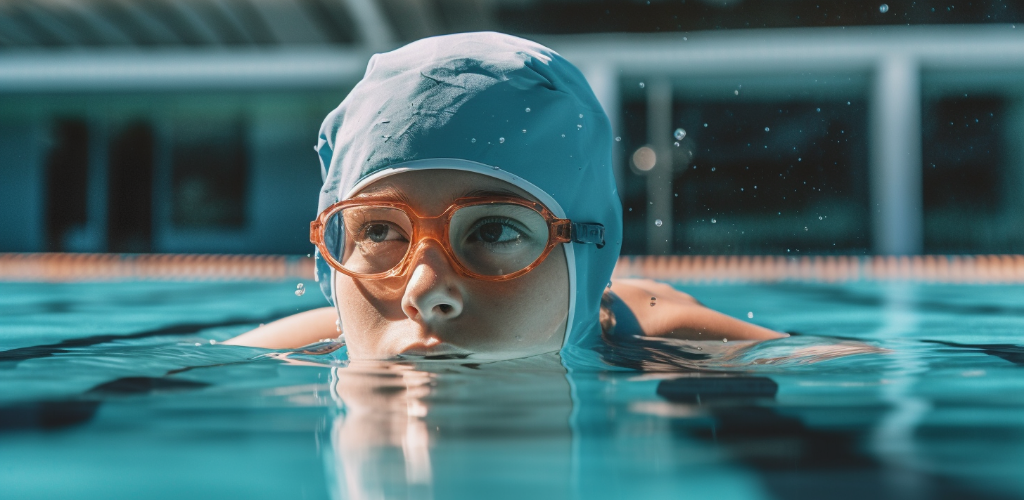Have you ever wondered why swimming caps are so prevalent in the world of water sports? You may have noticed them on professional athletes and swimming enthusiasts alike, but what exactly is the purpose of these caps? Well, the truth is, there’s more to swimming caps than meets the eye. They’re not just for show or fashion. In fact, swimming caps serve a very functional role in the water.
Often overlooked as a simple accessory, swimming caps actually play a crucial part in your swimming experience. They help enhance speed, reduce water resistance, and even protect your hair from the damaging effects of chlorine. Let’s dive in and explore the world of swimming caps.
The Core Purpose of Swimming Caps
At its core, a swimming cap is designed to minimize water resistance. This is a key factor in enhancing your speed in the water. The cap achieves this by creating a smooth surface that allows water to glide over your head more efficiently. Furthermore, swimming caps are excellent for protecting your hair from the damaging effects of chlorine found in most pools. Chlorine can have a drying effect and can cause discoloration in colored or light hair.
Common Materials Used in Swimming Caps
Swimming caps are typically made from a variety of materials, each with their own unique properties. The most common materials include latex, silicone, and nylon. But what makes these materials so special?
Latex is a popular choice due to its elasticity and tight fit. Silicone, on the other hand, is highly durable, thicker, and provides a more comfortable fit. Nylon swimming caps are lightweight and breathable, making them an ideal choice for casual or warm water swimming.
Each material offers its own set of advantages, and understanding these can help you make an informed choice when selecting your next swimming cap.
How Different Swimming Caps Suit Different Needs
Have you ever wondered why there are so many different types of swimming caps out there? It’s not just about fashion or personal preference. Different types of swimming caps are designed to meet individual needs and preferences. Some caps are designed for competitive swimmers, while others cater to leisure swimmers or those with specific needs such as long hair or sensitive skin. Let’s take a closer look at how different caps suit different needs.
Silicone Caps: For a Durable and Snug Fit
Silicone swimming caps are a popular choice among swimmers of all levels. Why? Well, one of the main reasons is their durability. Silicone is a sturdy material that can withstand regular use without tearing. This makes it an excellent choice for those who swim frequently.
Another advantage of silicone caps is their comfortable fit. They’re typically thicker than other types of caps, providing a snug fit without being too tight. Plus, they’re hypoallergenic, making them suitable for individuals with a latex allergy. Isn’t it great when comfort and health considerations go hand in hand?
Latex Caps: For the Budget-Conscious Swimmer
On the other hand, latex swimming caps might be a better option for those on a budget. They’re usually more affordable than silicone caps, making them a popular choice among casual swimmers and beginners. But don’t let the lower price tag fool you. Latex caps offer their own set of benefits.
One of these benefits is that latex caps provide a tighter fit. This can be beneficial for competitive swimming, where every second counts and reducing water resistance is crucial. So, if you’re into competitive swimming, latex might be the way to go.
Health and Hygiene Factors: A Closer Look
Swimming caps don’t just help you swim better—they also play a vital role in maintaining your hair’s health and hygiene. Ever noticed how your hair feels dry and rough after a swim? That’s because of the chlorine in the pool water. It can damage your hair, making it brittle and dry.
Here’s where a swimming cap comes in handy. It can protect your hair from direct contact with the chlorine, reducing its harmful effects. But that’s not all. Swimming caps also help prevent waterborne infections. They keep your hair neatly tucked away, minimizing the chance of loose strands getting into the pool and possibly spreading germs. So, it’s not just about performance—it’s about keeping you and others safe too!
The Competitive Edge: Why Professionals Choose Swimming Caps
Have you ever wondered why nearly every professional swimmer you see on TV wears a swimming cap? It’s not just a fashion statement – it’s a strategic choice. Professional swimmers are always on the hunt for ways to shave off milliseconds from their time, and one way they achieve this is by wearing swimming caps.
Swimming caps are designed to streamline a swimmer’s profile in the water, reducing drag and improving speed. When a swimmer’s hair is tucked neatly under a cap, there is less resistance against the water, allowing the swimmer to move more swiftly. It’s all about the aerodynamics!
Additionally, swimming caps can help maintain a swimmer’s body temperature, especially in cold water. This can be a significant advantage in long-distance swimming where maintaining body heat is crucial.
Do Swimming Caps Keep Your Hair Dry?
One of the most common misconceptions about swimming caps is that they are designed to keep your hair completely dry. But is that really the case?
Well, not exactly. While swimming caps do minimize the amount of water that comes into contact with your hair, they are not completely watertight. Some water is bound to seep in, especially during long or intense swimming sessions. So, if you’re planning to jump into the pool with perfectly styled hair expecting it to stay dry, you might be in for a surprise!
However, swimming caps do provide a layer of protection between your hair and the pool’s chlorinated water. This can help reduce the damage to your hair, keeping it healthier in the long run. So, even though they might not keep your hair completely dry, they’re still well worth wearing.
Swimming Cap Etiquette: What You Need to Know
Ever wondered about the proper etiquette when it comes to wearing swimming caps? Well, there are a few unspoken rules that swimmers, both professional and leisure, tend to follow. For instance, it’s generally considered necessary to wear a swimming cap during competitions or crowded swimming sessions. Not only does it show respect for the other swimmers, but it also helps to maintain a clean and safe swimming environment. The key, however, is to wear the right size and type of cap. Too tight, and it could lead to discomfort; too loose, and it might just slip off!
The Evolution of Swimming Caps
Isn’t it fascinating how even the simplest of things evolve over time? Swimming caps are no exception. They’ve come a long way from their early days, when they were merely seen as a fashion accessory for women, to now being recognized as an essential piece of swimming gear. The changes in design, materials, and purpose reflect the advances in technology and the evolving needs in the swimming world. Today’s caps are more durable, comfortable, and effective in reducing water resistance than their predecessors.
| Type | Advantages | Disadvantages | Suitable For |
|---|---|---|---|
| Silicone Caps | Durable, Snug Fit, Latex-free | More Expensive | Professional Swimmers, Swimmers with Latex Allergy |
| Latex Caps | More Affordable, Tighter Fit | Less Durable, Not Suitable for Latex Allergy | Competitive Swimming, Budget-Conscious Swimmers |
| Nylon Caps | Comfortable, Lightweight | Less Water-Resistant | Leisure Swimming, Water Aerobics |
Making the Right Choice: Selecting Your Ideal Swimming Cap
Choosing the right swimming cap can make a world of difference in your swimming experience. But how do you know which one is the ‘right’ one for you?
- Material: Consider whether you prefer the durability of silicone, the affordability of latex, or the comfort of nylon.
- Size: Make sure the cap fits snugly but not too tightly. It should cover all your hair without causing discomfort.
- Purpose: Are you a competitive swimmer looking for speed, or a leisure swimmer looking for comfort?
- Price: Determine your budget. Silicone caps tend to be more expensive than latex or nylon ones.
- Design: Lastly, don’t forget to pick a design that you love! After all, who says you can’t make a style statement while swimming?
Remember, the ‘right’ cap is one that meets your specific needs, preferences, and swimming goals. So, take your time, do your research, and make your choice. Happy swimming!




